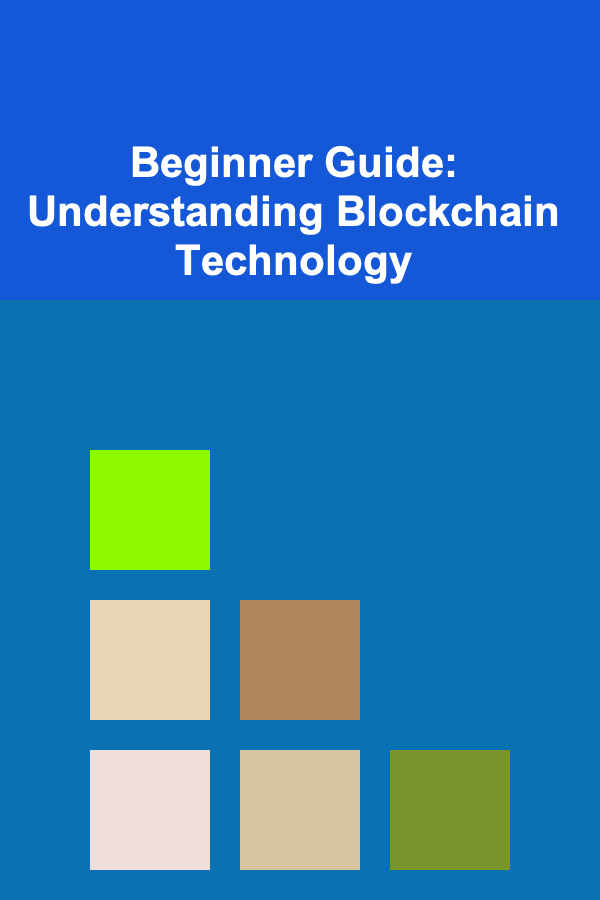
Beginner Guide: Understanding Blockchain Technology
ebook include PDF & Audio bundle (Micro Guide)
$12.99$11.99
Limited Time Offer! Order within the next:

Blockchain technology has emerged as one of the most transformative innovations of the 21st century. It powers everything from cryptocurrencies like Bitcoin and Ethereum to decentralized applications (dApps) and beyond. While it is often associated with digital currencies, its potential spans various industries, including finance, supply chain management, healthcare, and more.
In this actionable guide, we will break down the fundamental concepts of blockchain technology, how it works, its real-world applications, and how beginners can start understanding and using it.
What is Blockchain Technology?
At its core, a blockchain is a decentralized, distributed ledger or database that records transactions across many computers in a way that makes it difficult or impossible to alter the record. Each "block" in the chain contains a list of transactions, and these blocks are linked (or "chained") together in a way that ensures their integrity.
Key Features of Blockchain:
- Decentralization: Unlike traditional centralized systems, where a central authority (like a bank or government) controls the database, blockchain operates in a decentralized manner. This means no single entity owns the system. Instead, the control is distributed across a network of computers (also called "nodes").
- Transparency: Transactions on a blockchain are visible to everyone within the network. Once a block is added to the chain, the data is immutable, meaning it cannot be changed, deleted, or tampered with.
- Security: Blockchain uses cryptographic techniques to secure transactions and control the creation of new blocks. This makes it very difficult for malicious actors to alter the blockchain or conduct fraudulent transactions.
- Immutability: After a transaction is recorded on a blockchain, it is nearly impossible to alter the data without altering all subsequent blocks, which would require an enormous amount of computational power. This feature makes blockchain resistant to tampering and fraud.
How Does Blockchain Work?
To understand how blockchain works, let's break it down into simpler terms by describing a typical transaction on a blockchain network.
1. Initiating a Transaction
The process begins when a participant (also called a node) wants to make a transaction. This can involve the transfer of cryptocurrency, data, or other assets. The participant creates a transaction that contains:
- The sender's information (such as a public key or wallet address).
- The receiver's information (public key or wallet address).
- The transaction amount.
- A cryptographic signature to verify the sender's identity.
2. Broadcasting to the Network
Once the transaction is created, it is broadcasted to a network of nodes. Each node checks the validity of the transaction using predefined consensus rules. This ensures that the transaction is legitimate and that the sender has enough balance or permission to make the transaction.
3. Validation and Consensus
After receiving the transaction, the nodes must validate it through a consensus mechanism. There are various consensus algorithms in use (such as Proof of Work, Proof of Stake, and others), but the goal is to ensure that all nodes agree on the validity of the transaction before it is added to the blockchain.
For example, in Proof of Work (used by Bitcoin), miners compete to solve complex cryptographic puzzles. The first miner to solve the puzzle gets the right to add the next block of transactions to the chain and is rewarded with cryptocurrency. This process is known as mining.
4. Adding the Block to the Chain
Once a transaction is validated and the consensus is reached, the transaction is bundled into a new block along with other validated transactions. The new block is then added to the blockchain, making it part of the permanent record.
5. Finalization
The block is now part of the blockchain and cannot be altered. Once added, the transaction is considered complete, and the updated blockchain is replicated across all nodes in the network. This ensures that all participants in the network have an identical version of the blockchain.
Types of Blockchain
There are various types of blockchain networks, each serving different purposes. The three main types of blockchain are:
1. Public Blockchains
These are open to anyone and are fully decentralized. Anyone can join the network, validate transactions, and participate in the consensus process. The Bitcoin and Ethereum blockchains are examples of public blockchains. They are often used for cryptocurrencies and decentralized applications (dApps).
2. Private Blockchains
Private blockchains are restricted to specific participants. A single entity or a consortium controls the network, and only authorized parties can access and participate in the network. These blockchains are often used by businesses for internal purposes, such as tracking supply chains or managing databases securely.
3. Consortium Blockchains
A consortium blockchain is a hybrid between public and private blockchains. It is governed by a group of organizations, making it less centralized than a private blockchain but more restricted than a public one. Consortium blockchains are commonly used in industries where multiple parties need to collaborate while maintaining privacy and security.
Consensus Mechanisms
Blockchain networks use consensus mechanisms to validate and agree on the validity of transactions. These mechanisms are critical for ensuring the integrity and security of the blockchain. Here are the two most common consensus mechanisms:
1. Proof of Work (PoW)
Proof of Work is the consensus mechanism that powers Bitcoin. In PoW, miners compete to solve complex mathematical problems (cryptographic puzzles) to validate transactions and add them to the blockchain. The first miner to solve the problem gets to add the block and is rewarded with cryptocurrency.
While PoW is secure, it requires a lot of computational power and energy, which makes it environmentally inefficient.
2. Proof of Stake (PoS)
Proof of Stake is an alternative to Proof of Work and is used by Ethereum 2.0 and other blockchain projects. In PoS, validators (or "stakers") are chosen to create new blocks based on the number of coins they hold and are willing to "stake" as collateral. The more coins a person stakes, the higher their chances of being selected to validate the next block. Validators are rewarded for their participation.
Proof of Stake is more energy-efficient than Proof of Work, as it does not require miners to solve computational puzzles.
Real-World Applications of Blockchain
Blockchain technology has a wide range of applications beyond cryptocurrencies. Below are some key use cases:
1. Cryptocurrencies
Cryptocurrencies, like Bitcoin, Ethereum, and Litecoin, are the most well-known use case for blockchain technology. Blockchain provides the infrastructure to securely and transparently process transactions without the need for centralized intermediaries such as banks.
2. Supply Chain Management
Blockchain can enhance transparency and traceability in supply chains. Companies can use blockchain to track the movement of goods, ensuring that products are genuine, ethically sourced, and comply with regulations. This is especially useful in industries like food, pharmaceuticals, and luxury goods.
3. Smart Contracts
Smart contracts are self-executing contracts with the terms of the agreement written directly into code. When predefined conditions are met, the contract automatically executes without the need for intermediaries. Blockchain platforms like Ethereum are widely used for smart contracts, enabling applications such as decentralized finance (DeFi), insurance, and legal agreements.
4. Healthcare
In healthcare, blockchain can be used to securely store and share patient records. Patients can control who accesses their data, ensuring privacy and preventing unauthorized modifications. Blockchain also offers an opportunity for more efficient, transparent, and secure healthcare transactions.
5. Voting Systems
Blockchain has the potential to revolutionize voting systems by creating secure, transparent, and tamper-resistant digital voting platforms. This could reduce voter fraud and ensure election integrity.
6. Identity Verification
Blockchain technology can be used to create decentralized digital identities, where individuals can control their personal information without relying on centralized authorities. This can improve privacy and reduce the risks of identity theft.
How Can Beginners Get Started with Blockchain?
For beginners, diving into blockchain technology might seem daunting, but there are practical steps you can take to start understanding and using it.
1. Learn the Basics
Start by reading books, articles, and online resources about blockchain. Websites like Blockchain.com, Ethereum.org, and Coinbase Learn provide beginner-friendly guides to blockchain and cryptocurrencies.
2. Experiment with Cryptocurrencies
One of the easiest ways to interact with blockchain is through cryptocurrencies. You can create a wallet (using platforms like MetaMask or Coinbase) and purchase small amounts of cryptocurrency to see how transactions work in practice.
3. Participate in Blockchain Communities
Join online blockchain communities on platforms like Reddit, Twitter, or Discord. Engaging with other enthusiasts and experts will help you stay updated on the latest developments and deepen your understanding.
4. Develop Blockchain Skills
If you're interested in blockchain development, consider learning programming languages like Solidity (used for Ethereum smart contracts) or Rust (used for Solana). There are many online courses on platforms like Udemy, Coursera, and edX that offer blockchain development training.
Conclusion
Blockchain technology is a complex and revolutionary system that is changing the way we handle data and transactions. By understanding the core concepts of blockchain, its mechanisms, and its applications, beginners can tap into its immense potential. Whether you are interested in cryptocurrencies, decentralized applications, or blockchain's broader implications, this guide should provide a solid foundation for exploring and learning more about the world of blockchain.

Building a Successful Passive Income Model with AI and Deep Learning
Read More
How to Choose the Right Lighting for Your Living Room
Read More
How to Use Virtual Staging for a Competitive Edge
Read More
Mastering Spark Plug Gapping: A Comprehensive Guide for Optimal Engine Performance
Read More
From "Me" to "We": The Journey of Partnership
Read More
How to Control Portion Sizes Effectively
Read MoreOther Products

Building a Successful Passive Income Model with AI and Deep Learning
Read More
How to Choose the Right Lighting for Your Living Room
Read More
How to Use Virtual Staging for a Competitive Edge
Read More
Mastering Spark Plug Gapping: A Comprehensive Guide for Optimal Engine Performance
Read More
From "Me" to "We": The Journey of Partnership
Read More